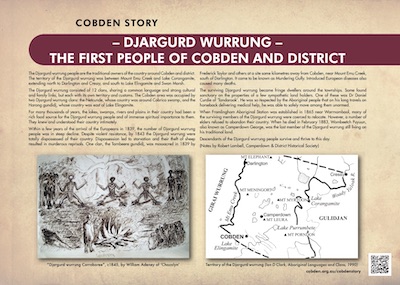First Nations

![]() This plaque is located on the Lake Cobden walking track, Shenfield St.
This plaque is located on the Lake Cobden walking track, Shenfield St.
The Djargurd wurrung people are the traditional owners of the country around Cobden and district. The territory of the Djargurd wurrung was between Mount Emu Creek and Lake Corangamite, extending north to Darlington and Cressy, and south to Lake Elingamite and Swan Marsh.
The Djargurd wurrung consisted of 12 clans, sharing a common language and strong cultural and family links, but each with its own territory and customs. The Cobden area was occupied by two Djargurd wurrung clans: the Netcunde, whose country was around Cobrico swamp, and the Horong gundidj, whose country was east of Lake Elingamite.
For many thousands of years, the lakes, swamps, rivers and plains in their country had been a rich food source for the Djargurd wurrung people and of immense spiritual importance to them. They knew and understood their country intimately.
Within a few years of the arrival of the Europeans in 1839, the number of Djargurd wurrung people was in steep decline. Despite violent resistance, by 1843 the Djargurd wurrung were totally dispossessed of their country. Dispossession led to starvation and their theft of sheep resulted in murderous reprisals. One clan, the Tarnbeere gundidj, was massacred in 1839 by Frederick Taylor and others at a site some kilometres away from Cobden, near Mount Emu Creek, south of Darlington. It came to be known as Murdering Gully. Introduced European diseases also caused many deaths.
The surviving Djargurd wurrung became fringe dwellers around the townships. Some found sanctuary on the properties of a few sympathetic land holders. One of these was Dr Daniel Curdie of ‘Tandarook’. He was so respected by the Aboriginal people that on his long travels on horseback delivering medical help, he was able to safely move among them unarmed.
When Framlingham Aboriginal Station was established in 1865 near Warrnambool, many of the surviving members of the Djargurd wurrung were coerced to relocate. However, a number of elders refused to abandon their country. When he died in February 1883, Wombeetch Puyuun, also known as Camperdown George, was the last member of the Djargurd wurrung still living on his traditional land.
Descendants of the Djargurd wurrung people survive and thrive to this day. (Notes by Robert Lambell, Camperdown & District Historical Society)

